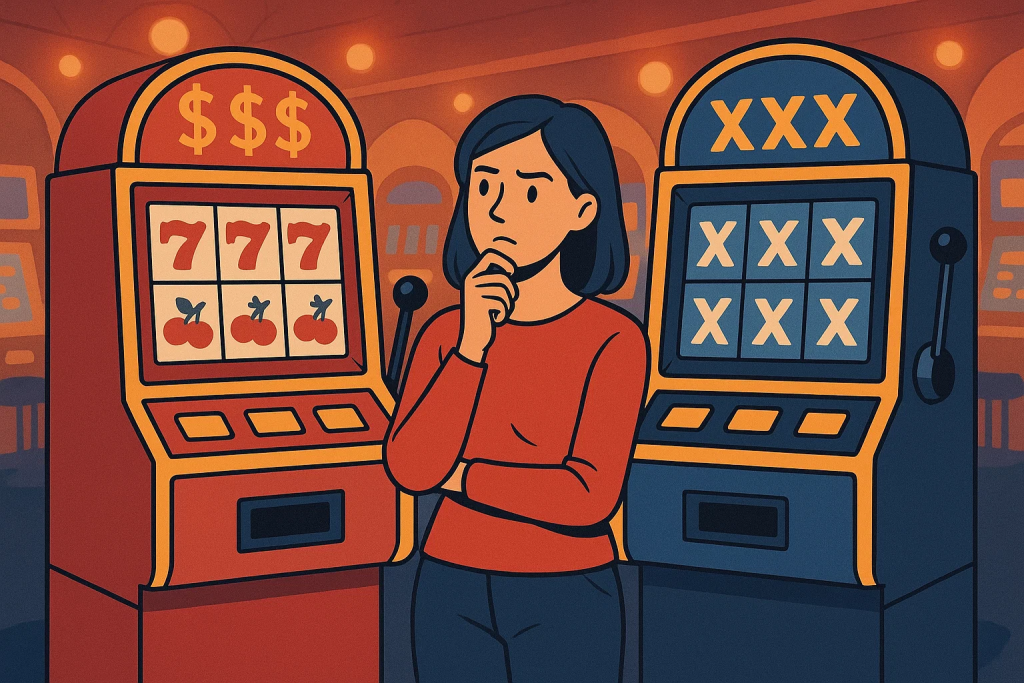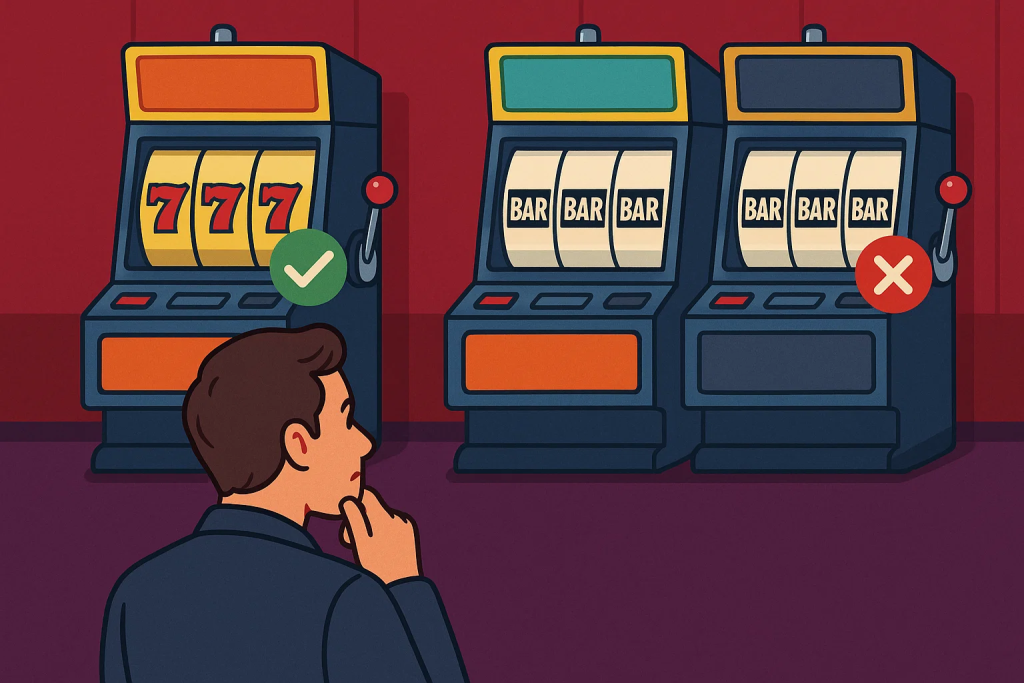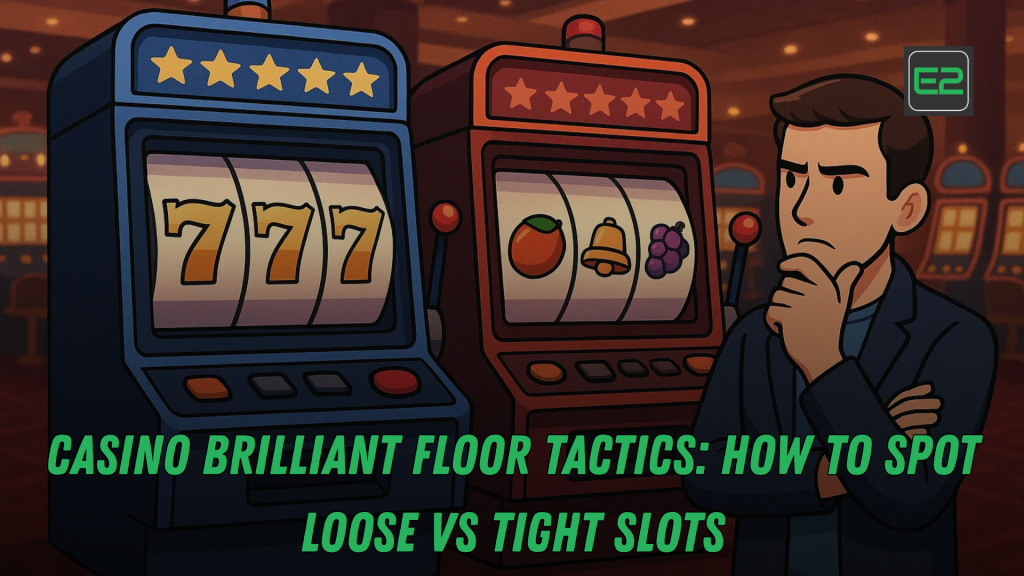Table of Contents
The Mystery Behind Loose and Tight Slots
If you’ve ever walked onto a casino floor, you’ve likely noticed the flashing lights, the constant hum of slot machines, and the thrill of watching players pull the lever or hit the spin button. For many, slots are the most popular choice for gambling due to their ease of play and potential for big payouts. But here’s the question every slot player wonders: How do you tell the difference between a loose slot and a tight slot?
While the outcome of any slot machine is largely determined by random number generators (RNGs), many seasoned players swear by certain tactics for spotting loose (high payout) vs. tight (low payout) machines. Understanding how to identify these slots can give you a better shot at maximizing your winnings and enhancing your overall experience.
In this article, we’ll dive deep into the tactics and methods for identifying loose vs tight slots, and provide you with the knowledge needed to improve your chances of winning on the casino floor. From the basics of slot machine mechanics to advanced strategies, we’ll cover everything you need to know.

What Are Loose and Tight Slots?
Before diving into the tactics of spotting loose and tight slots, let’s define the terms clearly:
1. Loose Slots:
A loose slot refers to a machine that offers higher payouts or a higher Return to Player (RTP) percentage over time. Players who consistently hit bonus rounds and higher-value symbols typically play on loose slots. These machines tend to give players more frequent wins, although the payouts are still subject to the game’s volatility.
2. Tight Slots:
A tight slot is the opposite. These machines have a lower RTP, meaning they pay out less frequently and often require players to invest more money before hitting a winning combination. Players may experience long stretches of losses with tight slots, making them less appealing for casual players looking for quick wins.
It’s important to note that both loose and tight slots are determined by the casino’s RNG system—there’s no way to predict with certainty when a machine will hit or how much it will pay. However, understanding the patterns and tactics can increase your odds.
Understanding Slot Machine Mechanics: RTP and Volatility
To better understand how to spot loose and tight slots, it’s essential to grasp the concepts of RTP (Return to Player) and volatility.
1. RTP (Return to Player):
RTP refers to the percentage of money that a slot machine will return to players over time. For example, a slot machine with an RTP of 96% will return 96% of the money wagered back to players in the long run, leaving the remaining 4% as the casino’s edge. Loose slots generally have a higher RTP, meaning they pay out more frequently.
- Loose Slots: Higher RTP (typically 95%–98% or more).
- Tight Slots: Lower RTP (often around 85%–92%).
While RTP gives you an idea of the average payout over thousands of spins, it’s important to note that this is an average. Individual sessions can still see significant fluctuations.
2. Volatility:
Volatility refers to the frequency and size of payouts in a slot game. High volatility slots pay out less frequently but offer larger jackpots, while low volatility slots provide more frequent, smaller wins.
- Loose Slots: Low to medium volatility, meaning more frequent wins.
- Tight Slots: High volatility, which results in longer dry spells but larger potential wins.
Choosing between a high volatility or low volatility machine depends on your risk tolerance and gaming preferences.
How to Spot Loose vs Tight Slots: Casino Floor Tactics
Now that you have a better understanding of RTP and volatility, let’s dive into the key tactics for spotting loose and tight slots on the casino floor.
1. Check for Higher Denominations:
While this is not a foolproof method, there is a general rule in casinos: higher denomination slots tend to be looser than lower denomination slots. Why? High-denomination slots typically offer higher payouts, and to attract players, casinos often set them at a higher RTP. So, if you’re looking for loose slots, try higher stakes machines.
2. Observe the Frequency of Hits:
One way to spot a loose slot is to watch for how frequently the machine hits bonus rounds, free spins, or special symbols. Machines that offer these more often are usually looser. Tight slots, on the other hand, tend to have longer stretches between hits. If a slot machine is awarding frequent small wins, chances are it is looser.
- Loose Slots: Frequent small wins, regular bonus rounds, free spins.
- Tight Slots: Long dry spells between wins, fewer bonus rounds.
3. Look for Progressive Jackpot Machines:
Progressive jackpot slots often have lower payout rates in comparison to non-progressive slots, as a portion of each bet contributes to the jackpot. However, they are usually looser machines to attract players hoping for the big win. If you’re looking for a loose slot, progressive jackpots could be a good choice.
4. Pay Close Attention to Machine Age and Location:
In some cases, older machines that are located in less-trafficked areas of the casino may be set to have a higher payout percentage to encourage players to engage with them. Conversely, newer machines, especially those in high-traffic areas, may be programmed to be tighter to minimize losses for the casino.
5. Examine the Machine’s History (When Possible):
Some casinos, particularly in online environments, may allow players to check the historical payout data for a specific slot machine. In brick-and-mortar casinos, it can be a bit more challenging to access this information, but monitoring trends can help. If you notice that a machine has paid out recently, there’s a chance that it could be in a “tight” cycle, and it might be better to walk away.
Myths About Loose and Tight Slots: What You Need to Know
1. Myth: Loose Slots Are Just Randomly Placed
One common myth about slots is that loose slots are placed at random locations on the casino floor. While it’s true that the placement of a machine doesn’t directly influence its RTP, casinos may strategically place more enticing machines in high-traffic areas to draw attention. Be cautious of relying on the location to determine a slot’s looseness.
2. Myth: Hitting a Jackpot Makes a Machine Tight
Many players believe that once a slot has hit a big jackpot, it becomes tight and less likely to pay out again. In reality, the outcome of each spin on a slot machine is independent due to the RNG. There is no “cooling off” period after a jackpot, so a machine that has just paid out a large sum can still be loose and ready to win again.
3. Myth: Casino Employees Can Influence Slot Machines
Casino employees do not have the ability to influence or control the outcome of a slot machine. The RNG governs every spin, ensuring fair and random results. If a slot machine is paying out more frequently, it’s simply due to chance, not the actions of casino staff.
Maximizing Your Slot Machine Winnings: Key Strategies
While it’s impossible to completely control or predict the outcome of a slot machine, there are several strategies that can help you maximize your winnings:
1. Set a Budget and Stick to It:
Before you start playing, set a budget for how much you are willing to spend. It’s important to play responsibly and avoid chasing losses.
2. Choose the Right Slot:
Understand the volatility and RTP of the slot machine. If you’re looking for frequent, smaller wins, choose a machine with low volatility. If you’re in for the thrill of potentially large payouts, go for a high volatility slot.
3. Use Bonus Offers and Promotions:
Many casinos offer bonus rounds or free spins as part of their promotional deals. These can be a great way to extend your playing time without spending more money.
4. Play Within Your Limits:
If you’re on a losing streak, know when to walk away. It’s easy to get caught up in the excitement of playing, but knowing when to stop is essential to maintaining your bankroll and enjoying the experience.

How to Spot Loose vs Tight Slots and Improve Your Chances of Winning
Identifying loose vs tight slots on a casino floor requires a mix of observation, strategy, and an understanding of slot machine mechanics like RTP and volatility. While there’s no guaranteed way to predict when a machine will pay out, paying attention to key indicators such as the machine’s denomination, the frequency of wins, and its location can improve your chances.
Ultimately, the best strategy for playing slots is playing responsibly and setting limits for yourself. By choosing machines with higher RTP, paying attention to volatility, and being aware of bonus opportunities, you can increase your chances of finding loose slots and having an enjoyable gaming experience.
Slot machines are one of the most popular and exciting forms of entertainment on the casino floor, attracting players with their flashing lights, engaging sounds, and the potential for big payouts. But with so many machines to choose from, how can you determine which ones are “loose” (pay out more frequently) versus “tight” (pay out less frequently)? The concept of loose and tight slots is a common topic among seasoned casino players, but understanding how to spot these types of machines requires knowledge of RTP (Return to Player), volatility, and key observations that can guide your choices.
Loose slots refer to machines that have a higher RTP, meaning they tend to return a larger portion of money to players over time, resulting in more frequent wins. These slots are often set to offer higher payouts, and players may find themselves hitting bonus rounds or larger payouts more often. In contrast, tight slots have a lower RTP, meaning they pay out less often and typically require players to wager more before hitting a significant win. While tight slots may offer larger jackpots, they are less frequent, leading to longer dry spells and more investment without consistent rewards.
One of the most crucial factors to understand when choosing a slot is RTP. This is the percentage of money wagered that a machine will return to players over time. For instance, a slot machine with an RTP of 96% will, on average, return 96% of the money wagered over a long period. Loose slots generally have higher RTPs, often between 95% and 98%, while tight slots might range from 85% to 92%. This means that by selecting slots with a higher RTP, you are statistically more likely to receive more frequent payouts. However, it’s important to remember that RTP is based on long-term averages, meaning your results in a single session can vary widely.
Volatility is another critical concept when it comes to spotting loose and tight slots. Volatility refers to the frequency and size of payouts. Slots with low volatility tend to offer more frequent, smaller wins, while those with high volatility may pay out less often but offer much larger jackpots. Loose slots often fall into the low to medium volatility category, meaning players are more likely to experience consistent small wins, keeping the gameplay exciting without significant risk.
Casino-Fixed Odds vs Table Games: Brilliant Player Strategy Shifts
Tight slots, on the other hand, are typically high-volatility machines, requiring players to be patient between payouts but offering the potential for larger prizes when they do occur. Understanding the volatility of a slot can help players determine whether they are in the mood for more frequent but smaller wins or larger, riskier payouts.
To spot loose vs tight slots, players can rely on several observations. One simple tactic is to look for higher denomination slots, which tend to be looser than lower-denomination machines. This is because higher-stakes machines generally offer larger payouts and are often set at a higher RTP to attract players willing to wager more. Watching the frequency of wins on a machine can also offer insights; loose slots often hit bonus rounds, free spins, or high-value symbols more regularly. If you notice a machine awarding frequent smaller wins or bonus features, it’s more likely to be loose. In contrast, tight slots tend to have long periods with minimal payouts and fewer bonus opportunities.
Progressive jackpot slots are often tighter than regular machines because they accumulate larger jackpots over time. Although these machines can offer massive rewards, they tend to have lower RTPs as a portion of each bet contributes to the jackpot. If you prefer more frequent wins, it might be better to avoid progressive slots and opt for non-progressive games, which are often looser. However, progressive jackpots can still be tempting if you’re looking for a big win.
Another important factor in identifying loose or tight slots is the machine’s age and location on the casino floor. Older machines located in less-trafficked areas may be looser, as casinos often use them to encourage players to engage with them. Newer machines, especially those located in high-traffic areas, may be set tighter to maximize the casino’s revenue. Observing the location of a slot machine and whether it is an older or newer model can give you some clues about its potential payout patterns, though this is not a foolproof method.
While it’s difficult to predict the outcome of any given spin due to the nature of random number generators (RNGs), several myths about loose and tight slots still persist. One such myth is that loose slots are randomly placed on the casino floor. In reality, while the placement of a machine doesn’t directly influence its RTP, casinos may place more enticing machines in high-traffic areas to attract players. Another myth is that once a slot hits a jackpot, it becomes tight.

However, RNGs ensure that each spin is independent, meaning there is no “cooling-off” period after a jackpot win. Additionally, some believe that casino employees can influence the outcomes of machines, but this is untrue. The results of all slot machines are determined by RNGs, and employees cannot interfere with the games.
To maximize your chances of winning, there are several strategies that can help you play smarter. First, always set a budget before you begin playing and stick to it. By managing your bankroll, you can avoid overspending and stay in the game longer. Choose machines with higher RTP, and decide if you prefer low volatility (for more frequent wins) or high volatility (for potentially larger, but less frequent, payouts). Taking advantage of bonus rounds and free spins can also extend your playtime without adding extra cost. Finally, know when to walk away. If you’re on a losing streak, it’s wise to step back and return another time rather than continuing to pour money into a tight machine.
Ultimately, understanding the dynamics of loose vs tight slots is about more than just picking a machine at random. By considering factors like RTP, volatility, and denomination, you can make informed decisions that improve your chances of having a successful and enjoyable experience. While no strategy can guarantee a win, applying these tactics and playing responsibly can increase your odds of finding a looser machine and having a better overall gaming experience.
Frequently Asked Questions (FAQ)
1. How can I identify a loose slot machine?
Loose slots tend to have a higher RTP (typically 95% or above), more frequent bonus rounds, and regular small payouts. These slots may also be located in areas with lower traffic to encourage players to try them.
2. Does the location of a slot machine affect its payout?
While the location doesn’t directly influence its RTP, casinos may place more enticing machines in high-traffic areas to attract players. However, the outcome of each spin is controlled by the RNG, not its location.
3. Are progressive jackpot slots tight?
Progressive jackpot slots are typically tight because they accumulate larger jackpots over time. However, they can still offer significant wins. If you’re looking for more frequent payouts, non-progressive slots are often better choices.
4. Can I increase my chances of winning at slots?
While there’s no way to predict the outcome of a spin, choosing slots with higher RTP, understanding their volatility, and managing your budget can increase your chances of having a positive experience.
5. Should I keep playing after a jackpot win?
Winning a jackpot doesn’t mean the machine is “done” paying out, but after a significant win, you may experience a dry spell due to the RNG’s nature. It’s up to you whether you wish to continue playing, but always play within your budget and limits.
Ready to try your luck at the casino? Now that you know how to spot loose vs tight slots, put these tactics to use and maximize your slot machine experience. Whether you’re aiming for big jackpots or frequent payouts, understanding RTP, volatility, and slot behavior can help you make better decisions on the casino floor. Happy spinning!
